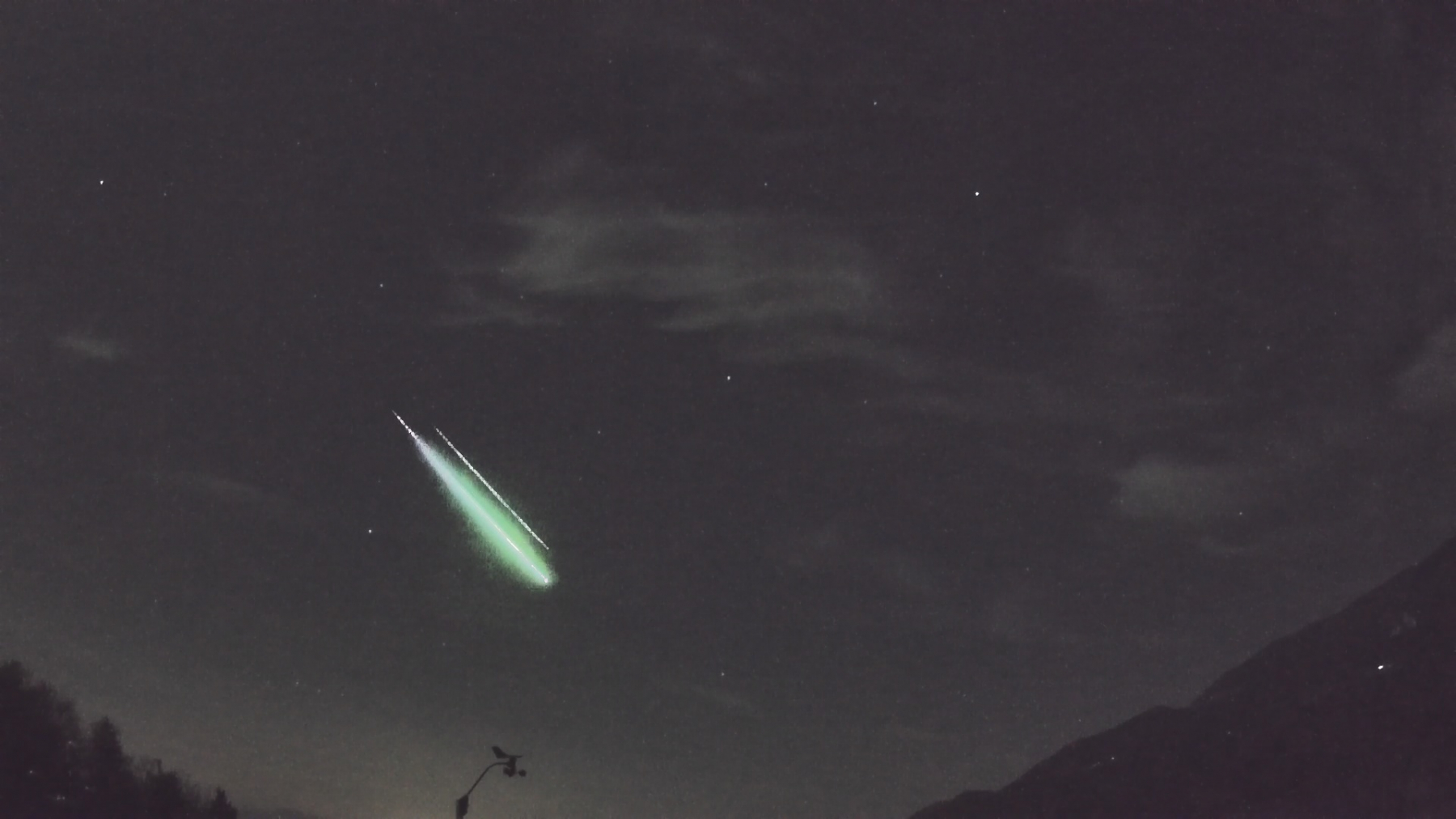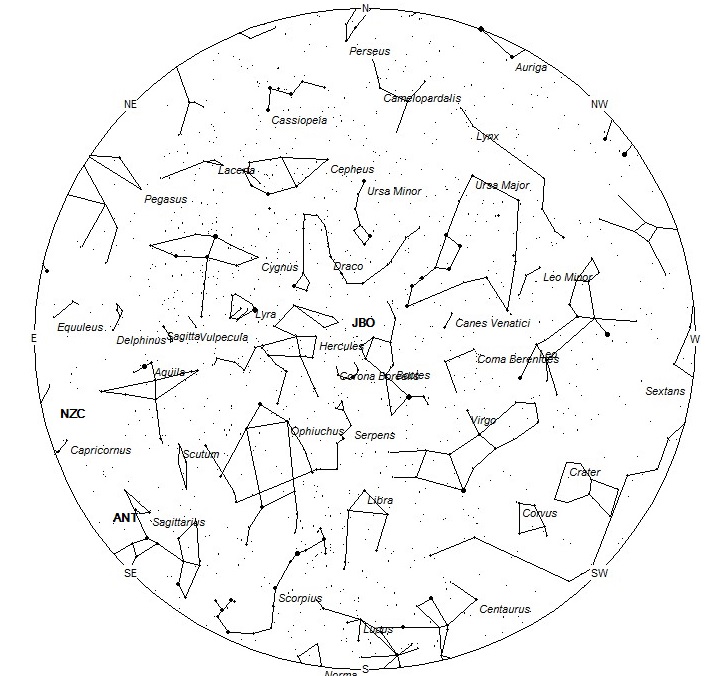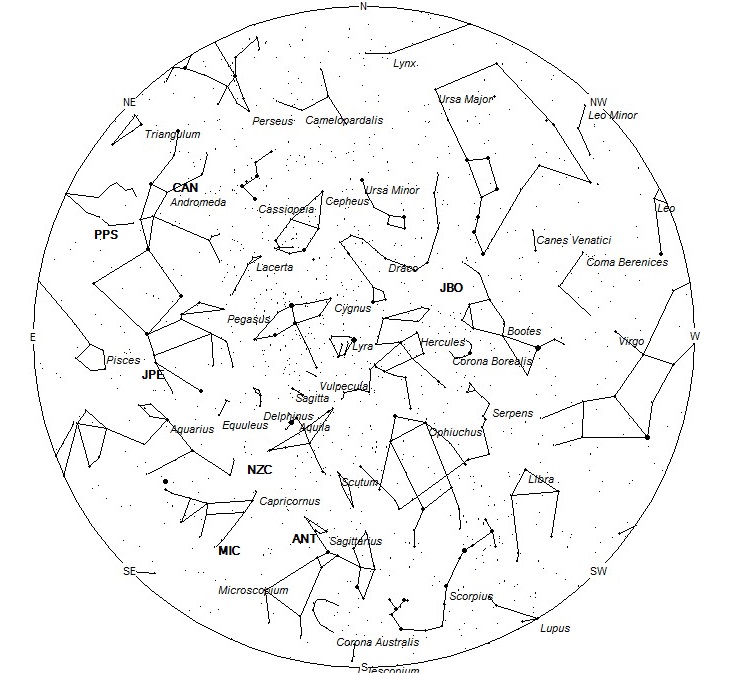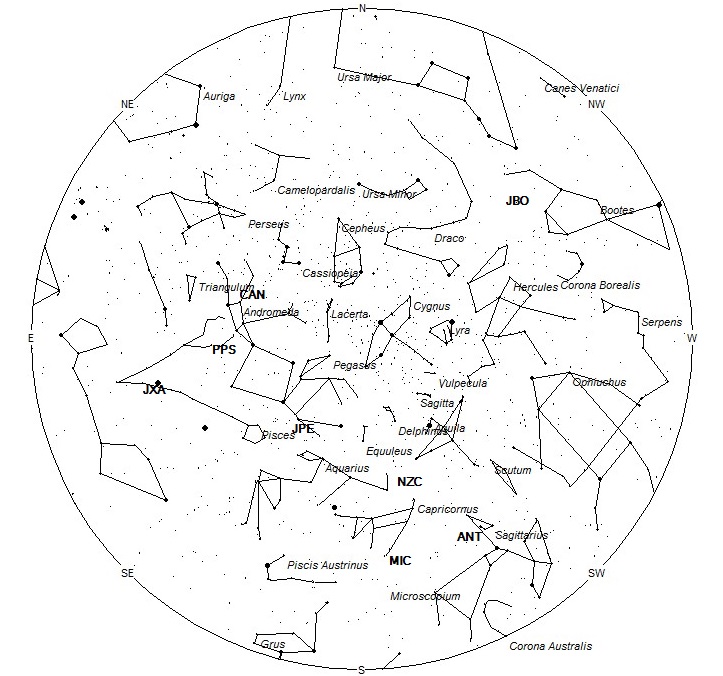 Javor Kac captured this fireball with his AllSky7 Camera System at 02:19 UT (22:19 CEST) on April 12, 2022, from Kamnik, Slovenia. For more information on this fireball visit: https://fireball.amsmeteors.org/members/imo_view/event/2022/2329 ©Javor Kac
Javor Kac captured this fireball with his AllSky7 Camera System at 02:19 UT (22:19 CEST) on April 12, 2022, from Kamnik, Slovenia. For more information on this fireball visit: https://fireball.amsmeteors.org/members/imo_view/event/2022/2329 ©Javor KacDuring this period, the moon reaches its new phase on Tuesday June 28th. At that time the moon is located near the sun and will be invisible at night. This weekend the waning crescent moon will rise shortly before dawn and will not interfere with meteor observing. The estimated total hourly rates for evening observers this week should be near 3 as seen from mid-northern latitudes (45N) and 4 as seen from tropical southern locations (25S) For morning observers, the estimated total hourly rates should be near 9 as seen from mid-northern latitudes (45N) and 11 as seen from tropical southern locations (25S). The actual rates will also depend on factors such as personal light and motion perception, local weather conditions, alertness, and experience in watching meteor activity. Note that the hourly rates listed below are estimates as viewed from dark sky sites away from urban light sources. Observers viewing from urban areas will see less activity as only the brighter meteors will be visible from such locations.
The radiant (the area of the sky where meteors appear to shoot from) positions and rates listed below are exact for Saturday night/Sunday morning June 25/26. These positions do not change greatly day to day so the listed coordinates may be used during this entire period. Most star atlases (available at science stores and planetariums) will provide maps with grid lines of the celestial coordinates so that you may find out exactly where these positions are located in the sky. I have also included charts of the sky that display the radiant positions for evening, midnight, and morning. The center of each chart is the sky directly overhead at the appropriate hour. These charts are oriented for facing south but can be used for any direction by rotating the charts to the desired direction. A planisphere or computer planetarium program is also useful in showing the sky at any time of night on any date of the year. Activity from each radiant is best seen when it is positioned highest in the sky, either due north or south along the meridian, depending on your latitude. It must be remembered that meteor activity is rarely seen at the radiant position. Rather they shoot outwards from the radiant, so it is best to center your field of view so that the radiant lies at the edge and not the center. Viewing there will allow you to easily trace the path of each meteor back to the radiant (if it is a shower member) or in another direction if it is sporadic. Meteor activity is not seen from radiants that are located far below the horizon. The positions below are listed in a west to east manner in order of right ascension (celestial longitude). The positions listed first are located further west therefore are accessible earlier in the night while those listed further down the list rise later in the night.
These sources of meteoric activity are expected to be active this week.
.
The June Bootids (JBO) are active from June 25-29 with maximum activity occurring on the 27th. At maximum the radiant is located at 14:48 (223) +48. This position lies in northwestern Bootes, 15 degrees east of the 2nd magnitude star known as Alkaid (Eta Ursae Majoris). This radiant is best placed in the evening sky just as the sky becomes dark. Observers in the northern hemisphere have a distinct advantage over those located south of the equator as the radiant lies much higher in the evening sky. No matter your location, little activity is expected from this source. With an entry velocity of 14 km/sec., the average June Bootid meteor would be of very slow velocity.
The large Anthelion (ANT) is currently centered at 19:08 (287) -22. This position lies in northern Sagittarius, 1 degree south of the 3rd magnitude star known as Albaldah (pi Sagittarii). This radiant is best placed near 01:00 LST when it lies on the meridian and is highest in the sky. Rates at this time should be near 2 per hour as seen from the Northern Hemisphere and 3 as seen from south of the equator. With an entry velocity of 30 km/sec., the average Anthelion meteor would be of slow velocity.
The Northern June Aquilids (NZC) were discovered by Zdenek Sekanina in 1976. These meteors are active from June 26 through July 22 with maximum activity occurring on July 15. The radiant is currently located at 20:18 (304) -07. This area of the sky is located in southern Aquila, 5 degrees north of the double star known as alpha Capricornii. This radiant is best placed near 0300 LST, when it lies on the meridian and is located highest in the sky. Hourly rates at this time should be less than 1 no matter your location. With an entry velocity of 40 km/sec., the average meteor from this source would be of medium-slow velocity. An interesting fact about this source is that it may be related to the Northern delta Aquariids of August. Where and when this source ends coincides with the start and position of the Northern delta Aquariids.
The Microscopiids (MIC) were discovered by G. Gartrell and W. G. Elford, in their study of Southern Hemisphere meteor streams. This stream is active from June 25 through July 16 with maximum activity occurring on July 6. The radiant is currently located at 20:37 (309) -28. This area of the sky is located on the Capricornus/Microscopium border, 4 degrees southwest of the 4th magnitude star known as omega Capricornii. This radiant is best placed near 0300 LST, when it lies on the meridian and is located highest in the sky. Hourly rates at this time should be less than 1 no matter your location. With an entry velocity of 40 km/sec., the average meteor from this source would be of medium-slow velocity. This shower is synonymous with the Southern June Aquilids (SZC).
The July Pegasids (JPE) are active from July 4th through August 8th with maximum activity occurring on July 11th. The radiant is currently located at 22:26 (337) +07. This area of the sky is located in southwestern Pegasus, 4 degrees southwest of the 3rd magnitude star known as Homam (zeta Pegasi). This radiant is best placed near 0500 LST, when it lies on the meridian and is located highest in the sky. Rates are expected to be less than 1 per hour this week no matter your location. With an entry velocity of 65 km/sec., the average meteor from this source would be of swift velocity.
The phi Piscids (PPS) have been found to be comprised of two components with separate activity periods. Component A is active from June 13 through July 5 with maximum activity occurring on June 25th. Current rates are less than 1 meteor per hour. The position of the radiant lies near 00:42 (011) +22. This position lies in southern Andromeda, 2 degrees southwest of the 4th magnitude star known as zeta Andromedae. This area of the sky lies highest in a dark sky during the last hour prior to dawn. With a entry velocity of 67km/sec., these meteors are swift.
The c-Andromedids (CAN) were discovered by Sirko Molau and Juergen Rendtel using video data from the IMO network. Activity from this source is seen from June 21 through July 28 with maximum activity occurring on July 12. The radiant currently lies at 01:00 (015) +43, which places it in northern Andromeda, 3 degrees northeast of the Great Andromeda Galaxy, which is visible to the naked eye as a small cloud. This area of the sky is best seen during the last dark hour before dawn when the radiant lies highest in a dark sky. Observers in the northern hemisphere are better situated to view this activity as the radiant rises much higher in the sky before dawn compared to southern latitudes. Current rates would be less than 1 per hour no matter your location. With an entry velocity of 57 km/sec., the average meteor from this source would be of swift velocity.
The July chi Arietids (JXA) were discovered by two investigating teams in Europe using video data from European video Meteor Network Database (EDMOND), SonotaCo, 2013; and CMN, 2013. Activity from this stream is seen from June 26 through July 22 with maximum activity occurring on July 7. The radiant currently lies at 01:33 (023) +03, which places it in southeastern Pisces, 3 degrees south of the faint star known as mu Piscium. This area of the sky is best seen during the last dark hour before dawn when the radiant lies highest in a dark sky. Current rates are expected to be less than 1 no matter your location. With an entry velocity of 68 km/sec., the average meteor from this source would be of swift velocity.
As seen from the mid-northern hemisphere (45N) one would expect to see approximately 7 sporadic meteors per hour during the last hour before dawn as seen from rural observing sites. Evening rates would be near 2 per hour. As seen from the tropical southern latitudes (25S), morning rates would be near 8 per hour as seen from rural observing sites and 2 per hour during the evening hours. Locations between these two extremes would see activity between the listed figures.
You can keep track of the activity of these meteor showers as well as those beyond the limits of visual observing by visiting the NASA Meteor Shower Portal available at: https://meteorshowers.seti.org/ You can move the sky globe to see different areas of the sky. Colored dots indicate shower meteors while white dots indicate sporadic (random) activity. The large orange disk indicates the position of the sun so little activity will be seen in that area of the sky.
| SHOWER | DATE OF MAXIMUM ACTIVITY | CELESTIAL POSITION | ENTRY VELOCITY | CULMINATION | HOURLY RATE | CLASS |
| RA (RA in Deg.) DEC | Km/Sec | Local Daylight Saving Time | North-South | |||
| June Bootids (JBO) | Jun 27 | 14:48 (223) +48 | 14 | 22:00 | <1 – <1 | III |
| Anthelion (ANT) | – | 19:08 (287) -22 | 30 | 02:00 | 2 – 3 | II |
| Northern June Aquilids (NZC) | Jul 15 | 20:18 (304) -07 | 40 | 03:00 | <1 – <1 | IV |
| Microscopiids (MIC) | Jul 06 | 20:37 (309) -28 | 40 | 03:00 | <1 – <1 | IV |
| July Pegasids (JPE) | Jul 11 | 22:26 (337) +07 | 64 | 04:00 | <1 – <1 | IV |
| phi Piscids A (PPS) | Jun 25 | 00:22 (006) +18 | 66 | 06:00 | <1 – <1 | IV |
| c-Andromedids (CAN) | Jul 12 | 00:35 (009) +40 | 56 | 06:00 | <1 – <1 | IV |
| July chi Arietids (JXA) | Jul 07 | 01:33 (023) +03 | 68 | 07:00 | <1 – <1 | IV |
 American Meteor Society
American Meteor Society



Uplighting as well as informative!